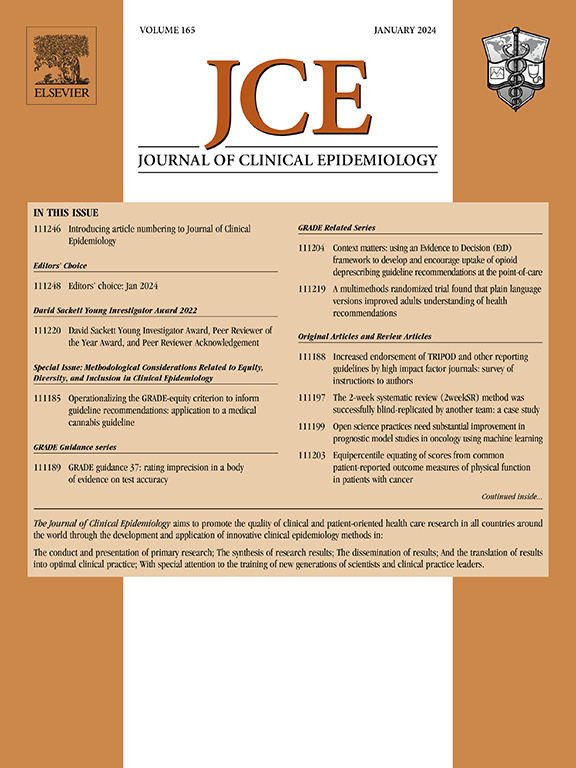评估一个作者或一个作者小组收集的作品的科学完整性。
IF 7.3
2区 医学
Q1 HEALTH CARE SCIENCES & SERVICES
引用次数: 0
摘要
目的:没有已发表的研究完整性评价方法既包括应用于随机试验组的统计技术,也包括对论文的个人评估。我们提出了一种基于调查一个作者或作者组收集的论文的数据完整性的实践经验的方法。研究设计和设置:我们报告了我们对涉嫌学术不端行为的作者或作者小组的论文进行调查的方法。结果:在调查一个作者或作者组的工作时,我们建议在PubMed、谷歌Scholar和RetractionWatch数据库中系统地搜索相关作者的工作,并在未发表的临床试验中搜索试验注册库。研究的摘要信息应制成表格,以评估研究注册、执行和发表之间的一致性。每篇论文都应该调查研究的治理、方法、执行、结果和报告的不可行的特征。论文间基线表和结果表的两两比较可能会发现数据重复或类似研究中基线特征之间存在不可思议的巨大差异。使用Carlisle的方法评估多个随机试验的基线特征可以确定数据是否与正确执行的随机化过程一致,也可以检查报告的基线特征是否遵循随机变量(如Benford定律)的预期模式。如果提出了严重的担忧,期刊、出版商和机构应该进行更彻底的调查。结论:这些方法为评价单个或多组作者的文集提供了一种系统的、可重复的方法。本文章由计算机程序翻译,如有差异,请以英文原文为准。
Assessing the scientific integrity of the collected work of one author or author group
Objectives
No published methods for research integrity review include both statistical techniques applied to groups of randomized trials and individual assessment of papers. We propose a method based on practical experience of investigating data integrity across the collected papers of an author or author group.
Study Design and Setting
We report our approach to investigating the collected papers of an author or author group suspected of academic misconduct.
Results
In the investigation of the work of an author or author group, we recommend a systematic search for the work of the involved authors in PubMed, Google Scholar, and the Retraction Watch database, as well as a search of trial registries for unpublished clinical trials. Summary information from studies should be tabulated to assess consistency between study registration, execution, and publication. Each paper should be investigated for unfeasible features of the governance, methodology, execution, results, and reporting of the study. Pairwise comparison of baseline and outcome tables between papers may reveal data duplication or unfeasibly large differences between baseline characteristics in similar studies. Assessment of baseline characteristics from multiple randomized trials using Carlisle’s method can determine whether the data are consistent with a properly executed randomization process, as can checking whether reported baseline characteristics follow expected patterns for random variables such as Benford’s law. If serious concerns are raised, a more thorough investigation should be performed by journals, publishers, and institutions.
Conclusion
These methods provide a systematic and reproducible way to assess the collected work of an author or group of authors.
Plain Language Summary
It is increasingly accepted that papers reporting on clinical studies may contain fraudulent or falsified data, often multiple papers by a single author or author group. Based on our experience assessing the research integrity of collections of papers by one author or author group, we present an approach to these investigations that combines published statistical methods with pragmatic assessment of study feasibility. This will help journals and publishers better identify groups of potentially untrustworthy studies.
求助全文
通过发布文献求助,成功后即可免费获取论文全文。
去求助
来源期刊

Journal of Clinical Epidemiology
医学-公共卫生、环境卫生与职业卫生
CiteScore
12.00
自引率
6.90%
发文量
320
审稿时长
44 days
期刊介绍:
The Journal of Clinical Epidemiology strives to enhance the quality of clinical and patient-oriented healthcare research by advancing and applying innovative methods in conducting, presenting, synthesizing, disseminating, and translating research results into optimal clinical practice. Special emphasis is placed on training new generations of scientists and clinical practice leaders.
 求助内容:
求助内容: 应助结果提醒方式:
应助结果提醒方式:


